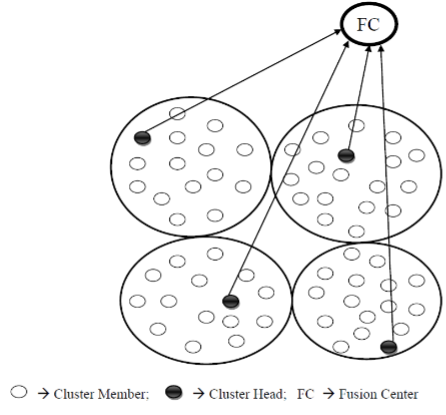A Novel Approach for Energy Efficient Cluster-based In-Network Data Fusion (CBDF) in Wireless Sensor Networks (WSN)
Keywords:
Wireless Sensor Network, Data aggregation, In-network data fusion, Clustering, Cluster HeadAbstract
In recent days, the usability of Wireless Sensor Network (WSN) has been immense in various applications, including environmental monitoring, disaster management, medical observance, military application, etc. WSN is a collection of numerous wireless sensor nodes interconnected with one another. It is widely used for sensing, communicating, and computing data efficiently. WSN is famous for its salient features like efficiency, minimum cost, flexibility, and ease to use. However, it is subject to severe challenges, especially in consuming enormous energy and minimum network lifetime. We proposed a Cluster-based In-Network Data Fusion (CBDF) for WSN. The proposed work is developed to minimize data fusion and clustering energy consumption. In WSN, if the in-network data fusion cannot minimize outgoing data size, it is a critical issue. The proposed CBDF restructures the network into multiple clusters based on its size. As a result, each cluster can communicate with the data fusion center in a synchronized approach. An optimization approach is used to reduce the distance of intra-cluster communication. The proposed structure is compared to other current data aggregation structures, and simulation results show that using the data aggregation process, the proposed approach successfully minimizes energy consumption and delays.
Downloads
References
Xu L, Collier R, O’Hare GMP. A survey of clustering techniques in WSNs and consideration of the challenges of applying such to 5G IoT scenarios. IEEE Internet Things J Oct. 2017;4(5):1229–49.
Jairam B, Ashoka DV, Multiple Mobile Elements Based Energy-Efficient Data Gathering Technique in Wireless Sensor Networks, in Digital Business; Lecture Notes on Data Engineering and Communications Technologies, Springer, vol. 21, July 2019.
Guo X, Chen Z, Hu X, Li X. Multi-source localization using time of arrival self-clustering method in wireless sensor networks. IEEE Access June 2019;7:82110–21.
L. N. Balai, G. K. J. A. K. S. (2022). Investigations on PAPR and SER Performance Analysis of OFDMA and SCFDMA under Different Channels. International Journal on Recent Technologies in Mechanical and Electrical Engineering, 9(5), 28–35. https://doi.org/10.17762/ijrmee.v9i5.371
Zhang Y, Liu M, Liu Q. An energy-balanced clustering protocol based on an improved CFSFDP algorithm for wireless sensor networks. Sensors March 2018;18(3):881.
Heinzelman WR, Chandrakasan A, Balakrishnan H, ‘‘Energy-efficient communication protocol for wireless microsensor networks,” Proceedings of the 33rd Annual Hawaii International Conference on System Sciences, Maui, HI, USA, 2000, pp. 10 pp. vol.2
S. A. Sert, H. Bagci, and A. Yazici, “MOFCA: multi-objective fuzzy clustering algorithm for wireless sensor networks,” Applied Soft Computing, vol. 30, pp. 151–165, 2015.
Roy, R., and D. A. . Kalotra. “Vehicle Tracking System Using Technological Support for Effective Management in Public Transportation”. International Journal on Recent and Innovation Trends in Computing and Communication, vol. 10, no. 2, Mar. 2022, pp. 11-20, doi:10.17762/ijritcc.v10i2.5515.
S. Amutha, B. Kannan, and J. M. Kanagara, “Energy-efficient cluster manager-based cluster head selection technique for communication networks,” International Journal of Communication Systems, vol. 33, no. 14, article e4427, 2020.
Chaudhary, D. S. . (2022). Analysis of Concept of Big Data Process, Strategies, Adoption and Implementation. International Journal on Future Revolution in Computer Science &Amp; Communication Engineering, 8(1), 05–08. https://doi.org/10.17762/ijfrcsce.v8i1.2065
S. Umbreen, D. Shehzad, N. Shafi, B. Khan, and U. Habib, “An energy-efficient mobility-based cluster head selection for lifetime enhancement of wireless sensor networks,” IEEE Access, vol. 8, pp. 207779–207793, 2020.
Safa’a S, Saleh, Tamer F. Mabrouk a, Rana A & Tarabishi, “An improved energy-efficient head election protocol for clustering techniques of wireless sensor network”, Egyptian Informatics Journal 22 (2021) 439–445, https://doi.org/10.1016/j.eij.2021.01.003
Sharma, A. (2022). Some Invariance Results for Isometries. International Journal on Recent Trends in Life Science and Mathematics, 9(2), 10–20. https://doi.org/10.17762/ijlsm.v9i2.131
W. R. Heinzelman, A. Chandrakasan, and H. Balakrishnan, “Energy-efficient communication protocol for wireless microsensor networks,” IEEE Computer Society, vol. 8, p. 8020, 2000.
Sehirli, E., & Alesmaeil, A. (2022). Detecting Face-Touch Hand Moves Using Smartwatch Inertial Sensors and Convolutional Neural Networks. International Journal of Intelligent Systems and Applications in Engineering, 10(1), 122–128. https://doi.org/10.18201/ijisae.2022.275
Gopalakrishnan Subburayalu, Hemanand Duraivelu, Arun Prasath Raveendran, Rajesh Arunachalam, Deepika Kongara & Chitra Thangavel (2021) Cluster Based Malicious Node Detection System for Mobile Ad-Hoc Network Using ANFIS Classifier, Journal of Applied Security Research, DOI: 10.1080/19361610.2021.2002118
P. Mohan Kumar & S. Gopalakrishnan (2016) Security Enhancement for Mobile Ad Hoc Network Using Region Splitting Technique, Journal of Applied Security Research, 11:2, 185-198, DOI: 10.1080/19361610.2016.1137204
Ahmed Cherif Megri, Sameer Hamoush, Ismail Zayd Megri, Yao Yu. (2021). Advanced Manufacturing Online STEM Education Pipeline for Early-College and High School Students. Journal of Online Engineering Education, 12(2), 01–06. Retrieved from http://onlineengineeringeducation.com/index.php/joee/article/view/47
Gopalakrishnan, S. and Kumar, P. (2016) Performance Analysis of Malicious Node Detection and Elimination Using Clustering Approach on MANET. Circuits and Systems, 7, 748-758. DOI: 10.4236/cs.2016.76064.
Panimalar Kathiroli, Kanmani Selvadurai ",Energy-efficient cluster head selection using improved Sparrow Search Algorithm in Wireless Sensor Networks"Journal of King Saud University - Computer and Information Sciences, https://doi.org/10.1016/j.jksuci. 2021.08.031. 2021,

Downloads
Published
How to Cite
Issue
Section
License

This work is licensed under a Creative Commons Attribution-ShareAlike 4.0 International License.
All papers should be submitted electronically. All submitted manuscripts must be original work that is not under submission at another journal or under consideration for publication in another form, such as a monograph or chapter of a book. Authors of submitted papers are obligated not to submit their paper for publication elsewhere until an editorial decision is rendered on their submission. Further, authors of accepted papers are prohibited from publishing the results in other publications that appear before the paper is published in the Journal unless they receive approval for doing so from the Editor-In-Chief.
IJISAE open access articles are licensed under a Creative Commons Attribution-ShareAlike 4.0 International License. This license lets the audience to give appropriate credit, provide a link to the license, and indicate if changes were made and if they remix, transform, or build upon the material, they must distribute contributions under the same license as the original.





